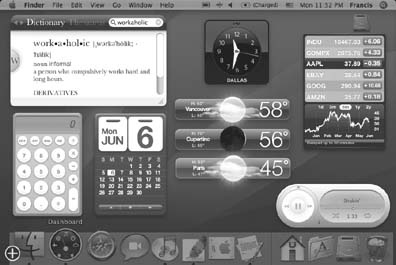Dashboard
As you know, the essence of using Mac OS X is running programs, which often produce documents. In Tiger, however, there's a third category: a set of weird, hybrid entities that Apple calls widgets. They appear, all at once, floating in front of your other windows, when you press the F12 key. Welcome to the new Tiger environment called the Dashboard (Figure 5-20).
Note
You can change this keyboard assignment, as described below. Also, on laptops where F12 is the Eject key, you also have to hold down the Fn key (lower-left corner).

Figure 5-20. When you summon the Dashboard, you get a fleet of floating mini-programs that convey or convert all kinds of useful information. They appear and disappear all at once, on a tinted translucent sheet that floats in front of all your other windows. You get rid of Dashboard either by pressing the same key again (F12 or whatever) or by clicking anywhere on the screen except on a widget.
What are these weird, hybrid entities, anyway? They're not really programs, because they don't create documents or have Dock icons (although Dashboard itself has a Dock icon). They're certainly not documents, because you can't name or save them. What they most resemble, actually, is little Web pages. They're meant to display information, much of it from the Internet, and they're written using Web programming languages like HTML and JavaScript.
Tiger's starter ...
Get Mac OS X: The Missing Manual, Tiger Edition now with the O’Reilly learning platform.
O’Reilly members experience books, live events, courses curated by job role, and more from O’Reilly and nearly 200 top publishers.

